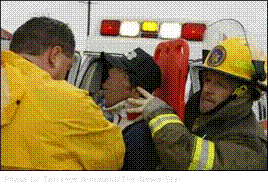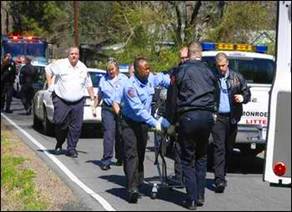

|
“Our Mission Is To Provide Quality Public Service, Public Education, and Professional Emergency Response” |
|
Monroe Fire Department 1810 Martin Luther King Blvd Monroe, LA (318)329-2474 Jimmie R. Bryant, Fire Chief |
| EMSNetwork Latest News |



|
International Association of Fire Chiefs |
|
International Association of Firefighters |

|
National Association For Search and Rescue |

|
National Association of Emergency Medical Technicians |

|
National Fire Fighter Near-Miss Reporting System |

|
Emergency Medical Services (EMS)
The citizens and visitors of the City of Monroe benefit daily from the cross-trained firefighters of the Monroe Fire Department. Almost all of our responders are certified as Emergency Medical Technicians (EMT) by the National Registry of Emergency Medical Technicians. This is a 120-hour didactic classroom education combined with hours of clinical practice in a hospital and ambulance environment.
|
|
THE LIFE CYCLE OF A TYPICAL EMERGENCY MEDICAL CALL
The full life cycle of an EMS call begins at 0800 hours at each Monroe Fire Department fire station. At this time, which coincides with the 8am beginning of shift, each person assigned to an apparatus reports to the truck and evaluates the readiness of the unit to which he or she is assigned. In addition to checking the fuel level, lights, and siren, they evaluate the equipment, specifically the EMS equipment, which includes the EMS bag (the “Thomas Pack™”), an oxygen bottle for delivery to patients, an AED or in some cases a combination AED and EKG unit, and a “drug bag” which contains drugs for delivery to patients in cardiac and respiratory compromise. Each bag is examined for completeness and readiness. This is the first phase of EMS response.
When a citizen recognizes the need for EMS, he or she should call 911. At the 911 center, the call is promptly answered and a few qualifying questions are asked of the caller regarding the nature of the emergency. Then, the call is transferred to the contracted private ambulance provider’s dispatch center, where the more specific questions are asked regarding the symptoms, signs, and complaint the patient may have, or a description of the incident. Usually, the closest or only available ambulance is “pre-alerted” to the incident. Then, after gathering more information about the severity of the medical emergency and determining if the call falls within the city limits, the Monroe Fire Department dispatch is alerted by the private ambulance service by way of radio pager. At this point, the Monroe Fire dispatcher receives the call from the ambulance service, determines the closest fire apparatus, and depending on the nature of the call, selects additional units to send to the incident. The fire units are dispatched, including the local neighborhood Engine Company, and they begin their response.
|
|
Many more have gone on to continue their EMS education, attaining their Paramedic certification, which educates and trains the firefighters in advanced life support, being able to perform skills such as IV therapy, EKG monitoring, defibrillation, advanced airway control (endotracheal intubation) and drug therapy.
Each fire apparatus is equipped with its own Thomas Pack™ which stores all of the basic and advanced life support supplies and equipment. Some apparatuses are equipped with an advanced EKG/AED, which not only can be used by all of our responders to deliver the life-saving defibrillation to a victim of sudden cardiac arrest (SCA) but can also be used by our paramedics to monitor the patient’s 3-lead EKG and deliver a pacing rhythm.
|
|
Upon arrival at the incident address, the first fire unit assesses the incident, whether it is a medical-oriented incident related to a sick person, or a victim of trauma such as a fall or a motor vehicle accident. If care is needed, it is immediately offered at the appropriate level needed and according to the level-of-care of the responders. Vital signs are gathered, the patient is administered oxygen, or other interventions needed to evaluate and stabilize the patient. During this process, the ambulance service arrives, and a report is given to the paramedic on the ambulance regarding any findings by the fire personnel, and care of the patient is formally transferred to the ambulance personnel.
The Monroe Fire personnel continue to provide patient care and manpower in loading the patient onto the stretcher and into the ambulance, to help insure the comfort and safety of the patient and the proper care of the patient by the ambulance responders.
After the patient is loaded into the ambulance, the incident is not complete for the Monroe Fire responders. Any supplies used in care of the patient will be replenished, and any equipment used will be cleaned.
|
|
After returning to the station, the Company Officer insures the entire incident is documented both on paper and in the computerized EMS reporting system, including times related to the incident, what was seen and found, quantity and conditions of each patient, any treatment given, and how patient care was terminated, whether by transfer to an ambulance paramedic or another provider. |


|
In foreground L-R, Monroe Fire Department personnel Captain / Paramedic Kenny Menyweather, Training Officer / Paramedic Greg Hill (facing away), and Lieutenant / Paramedic Bronson Moss render care to a recent victim of a shooting incident. Photo by Michael Dunlap/The News-Star |
